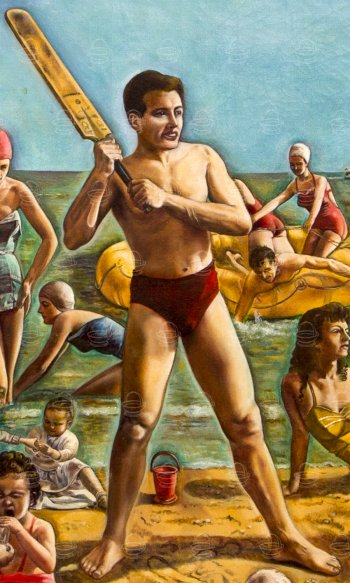
Click image to see large image
Britain by the Sea (1961)
Britain by the Sea is the largest canvas that NMK ever painted. The dimensions lend the richly peopled painting a monumental frieze-like quality. It was executed when Norman and Renée had been living in Edgware for a decade and after the birth of their three daughters. As always, he preferred to draw from life, but a shortage of models willing to pose forced him to rely on photographs of himself and his family. He developed an interest in photography, both still and movie (Super 8mm ciné), invested in the latest cameras and mastered the necessary skills. For many of his complex compositions of the 1960s and 1970s, he took black and white stills of himself, dressed the part, and used a cable release to produce the equivalent of today’s ‘selfie’. So it is not surprising that many of the characters in these paintings bear more than a passing resemblance to the artist.
In Britain by the Sea, portraits of Renée and Norman, in sunglasses, holding his oldest daughter Helen, can be seen in the background at the far left. The family appear several times in the tableau. In the foreground, Helen’s baby doll Maria sits in front of a group of children playing on the sand. Nearby, the painting is signed and dated on the children’s comic lying next to the child crouching in the extreme corner where the artist also added his trademark cakedish monogram. A model, thought to be a teaching colleague of Renée’s, posed for most of the women in swimwear, including the fair-haired girl in the dark blue costume sitting on the deck chair on the left hand side.
This painting depicts a quintessentially English scene, a crowded beach on a beautiful summer’s day. However, it is not naturalistic and freely handled like the beach scenes that NMK painted towards the end of his life, when he returned to the seaside theme, using informal colour photographs, snapped whilst on holiday in Eastbourne or Jersey. Britain by the Sea, in common with The Lambeth Walk, is a mannered work, somewhat contrived and almost classical in its composition. The artist worked out the design in a preliminary sketch on paper that he then coloured up with paint. His more usual method was to draw a pencil cartoon to scale.
The canvas is divided horizontally into three elements, denoted by a change of colour: blue sky, blue-green sea and golden sand. The tall young man in swimming trunks wielding the cricket bat is placed dead centre. All of the other people on the beach, in their various vignettes, serve to frame him on either side. The fat lady’s curve is echoed in the red and yellow sunshade and in the shawl draped over the woman who is changing on the beach, in the act of taking off her stocking. The mast of the small boat sloping leftwards and the V-shaped outstretched arms of the girl jumping for joy on the right, provide vertical accents that complement the cricket bat set against the bright blue sky. The dynamic pose of the girl leapfrogging over her brother or boyfriend was based on a photograph that NMK cut out of a holiday brochure (the clipping is still extant).
This fascinating painting was rarely exhibited in the artist’s lifetime. It was a bit too big to transport easily, so it always hung in the front sitting room in Edgware. A more natural home, along with The Lambeth Walk, would be in a gallery, perhaps even the Tate.